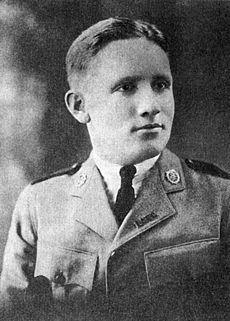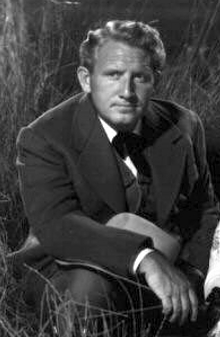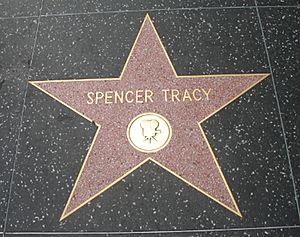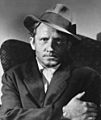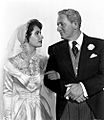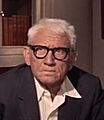Spencer Tracy facts for kids
Quick facts for kids
Spencer Tracy
|
|
|---|---|

Tracy in State of the Union (1948)
|
|
| Born | April 5, 1900 Milwaukee, Wisconsin, U.S.
|
| Died | June 10, 1967 (aged 67) |
| Burial place | Forest Lawn Memorial Park, Glendale |
| Alma mater | Ripon College, Wisconsin |
| Occupation | Actor |
| Years active | 1921–1967 |
| Spouse(s) |
Louise Treadwell
(m. 1923; sep. 1933) |
| Partner(s) | Katharine Hepburn (1941–1967) |
| Children | 2 |
| Signature | |
Spencer Bonaventure Tracy (born April 5, 1900 – died June 10, 1967) was a famous American actor. He was known for his natural acting style and how well he could play many different kinds of characters. Spencer Tracy was one of the biggest stars during Hollywood's Golden Age. He was the first actor to win two Academy Awards for Best Actor in a row. He was nominated nine times in total.
During his career, Spencer Tracy acted in 75 movies. Many people in Hollywood thought he was one of the greatest actors on screen. In 1999, the American Film Institute named him the 9th greatest male star of Classic Hollywood Cinema.
Tracy first found his love for acting while studying at Ripon College. He later earned a scholarship to the American Academy of Dramatic Arts. He spent seven years performing in plays, both in local theater groups and on Broadway. He became well-known in 1930 for his main role in the play The Last Mile. This performance caught the eye of Hollywood.
After a successful first movie, Up the River (1930), he signed a contract with Fox Film Corporation. Tracy made 25 films with Fox over five years. Many of his performances were highly praised, but most of these movies were not big hits. He remained largely unknown to movie audiences during this time.
In 1935, Tracy joined Metro-Goldwyn-Mayer (MGM), which was Hollywood's most important studio. His career really took off after his fifth MGM film, Fury (1936). In 1937 and 1938, he won back-to-back Oscars for Captains Courageous and Boys Town. He also starred with Clark Gable in three very popular movies. By the early 1940s, Tracy was one of MGM's top stars.
In 1942, he made Woman of the Year with Katharine Hepburn. This movie started a special partnership between them, both in their work and in their personal lives. They made nine films together over 25 years. In 1955, Tracy won the Cannes Film Festival Award for Best Actor for his role in Bad Day at Black Rock.
Tracy left MGM in 1955 and continued to work as a freelance actor. He faced some health problems as he got older. His personal life was complicated, and he felt sad about his son's deafness. Tracy and his wife Louise separated in the 1930s but never divorced. His long relationship with Katharine Hepburn was known to many in Hollywood. Towards the end of his life, Tracy worked mostly with director Stanley Kramer. His last film was Guess Who's Coming to Dinner (1967), which he finished just 17 days before he passed away.
Contents
Early Life and Acting Start
Spencer Bonaventure Tracy was born in Milwaukee, Wisconsin, on April 5, 1900. He was the second son of Caroline and John Edward Tracy. His mother came from a wealthy family, and his father was of Irish Catholic background.
As a child, Tracy was very active and sometimes had trouble in school. He was raised Catholic. He became very interested in movies, watching them many times and then acting out scenes for his friends. In his teenage years, he attended several Jesuit schools, which he said helped him improve his behavior and grades.
At Marquette Academy, he started going to plays with his friend Pat O'Brien. This sparked his interest in theater. When Tracy turned 18, he and O'Brien joined the Navy together during World War I. They were still students when the war ended. Tracy was discharged in February 1919.
His father wanted one of his sons to get a college degree. So, Tracy went back to high school to finish his diploma. With extra "war credits," he got a spot at Ripon College in February 1921. He planned to study medicine.
Tracy was a popular student at Ripon. He made his acting debut in June 1921, playing the main male role in The Truth. He was very good in the part and quickly fell in love with acting. He and some friends even formed an acting group called the Campus Players and went on tour.
While on a debate team tour, he auditioned for the American Academy of Dramatic Arts (AADA) in New York City. He was offered a scholarship after performing a scene. Tracy left Ripon and started classes at AADA in April 1922. He made his New York debut in a play called The Wedding Guests in October 1922. Three months later, he appeared on Broadway as a robot in R.U.R. He graduated from AADA in March 1923.
Career Highlights
Early Theater Work (1923–30)
After graduating, Tracy joined different theater groups. He had some small roles and faced challenges. In November 1923, he got a small part on Broadway in A Royal Fandango. The show didn't do well and closed quickly.
Tracy finally found success in 1924 with manager William H. Wright. He formed a popular acting team with actress Selena Royle. Their shows were well-received. One performance led to a Broadway producer offering him a lead role in a new play, The Sheepman. However, this play also closed after a short run.
In 1926, Tracy got another chance on Broadway in a George M. Cohan play called Yellow. It ran for 135 performances, which was a good run. Cohan then wrote a part just for Tracy in his next play, The Baby Cyclone, which was a hit on Broadway in 1927.
Tracy continued to act in plays. In January 1930, he was offered the lead role in The Last Mile. He played a murderer on death row. The producer, Herman Shumlin, saw Tracy's strong emotions and knew he was right for the part. The Last Mile opened on Broadway in February. Tracy's performance received a standing ovation and 14 curtain calls. Critics praised him, calling him "one of our best and most versatile young actors." The play was a big hit.
Moving to Hollywood (1930–35)
In 1930, Hollywood was looking for theater actors for the new "talkie" movies. Tracy was cast in two short films. He didn't plan to be a film actor, saying he was happy on stage. However, director John Ford saw Tracy in The Last Mile and wanted him for his next movie.
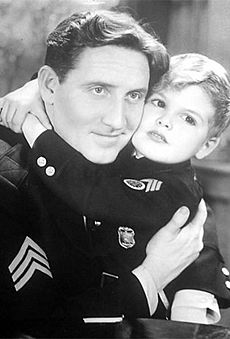
The production company, Fox Film Corporation, wasn't sure about Tracy. They thought he didn't look good on camera. But Ford convinced them he was perfect. Up the River (1930) was the first film for both Tracy and Humphrey Bogart. After seeing the early footage, Fox immediately offered Tracy a long-term contract. Tracy needed money for his family, especially because his young son was deaf and recovering from polio. So, he signed with Fox and moved to California. He only acted on stage one more time after that.
Fox wanted to make Tracy a big star. They promoted his second film, Quick Millions (1931), with headlines like "A New Star Shines." He made three more films quickly, but none were successful. Tracy often played crooks or con men in comedies. His seventh film, Disorderly Conduct (1932), was his first to make a profit since Up the River.
By mid-1932, after nine movies, Tracy was still not well-known. He thought about leaving Fox, but a pay raise convinced him to stay. He continued to appear in unpopular films. He was loaned to Warner Bros. for 20,000 Years in Sing Sing (1932), a prison drama with Bette Davis. Despite good reviews, it wasn't his big break.
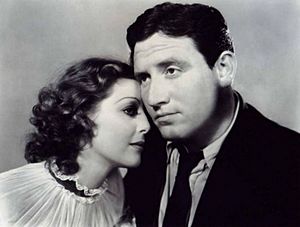
Critics started to notice Tracy with The Power and the Glory (1933). Tracy's performance as a railroad boss received very strong reviews. The Hollywood Reporter said he was "one of the screen's best performers." His next two movies didn't get much attention. Man's Castle (1933) with Loretta Young made only a small profit. The Show-Off (1934), made while he was loaned to MGM, was popular.
Tracy had some issues with Fox. In June 1934, he didn't show up for filming Marie Galante. Fox removed him from their payroll and sued him. He made only two more movies with the studio. In April 1935, MGM offered him a seven-year contract. That same afternoon, his contract with Fox ended. Tracy had made 25 films with Fox, but most of them lost money.
Becoming a Star at MGM (1935–55)
Rising Fame
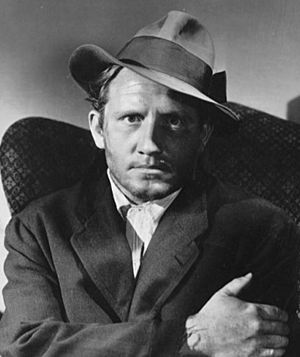
In the 1930s, Metro-Goldwyn-Mayer (MGM) was the most respected movie studio in Hollywood. When Tracy arrived, he was not well-known to the public. However, producer Irving Thalberg believed in him, saying, "Spencer Tracy will become one of MGM's most valuable stars."
MGM managed Tracy's career carefully, which was a positive change for him. His first film for MGM was The Murder Man (1935), which also featured James Stewart's first movie role. Thalberg then paired Tracy with top actresses. Whipsaw (1935) with Myrna Loy was a success. Riffraff (1936) starred Tracy opposite Jean Harlow. These films helped Tracy, but they mainly focused on the leading ladies.
Fury (1936) was the first film to show Tracy could be a success on his own. Directed by Fritz Lang, Tracy played an innocent man who seeks revenge after almost being killed by a mob. The film and his acting received excellent reviews. It made a profit of $1.3 million worldwide. Audiences started to come out to see him, showing they liked a leading man who wasn't just handsome.
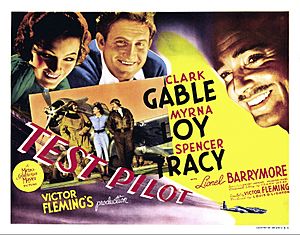
One month later, the disaster movie San Francisco (1936) was released. Tracy played a priest alongside Clark Gable, Hollywood's top male star. Tracy felt a great responsibility in playing the priest. Even though he was only on screen for 17 minutes, he was highly praised and received an Oscar nomination. San Francisco was the highest-grossing movie of 1936. These two films, Fury and San Francisco, changed his career and made him a major star.
Tracy became more professional, and MGM was pleased. His public image grew with Libeled Lady (1936), a comedy with William Powell, Loy, and Harlow. This was his third hit movie in six months.
Winning Oscars
Tracy appeared in four films in 1937. They Gave Him a Gun went mostly unnoticed. But Captains Courageous was a major film event. Tracy played a Portuguese fisherman in this adventure movie, based on a novel by Rudyard Kipling. He didn't like faking a foreign accent or having his hair curled. But audiences loved the role, and Tracy won the Academy Award for Best Actor.

Captains Courageous was followed by Big City with Luise Rainer and Mannequin with Joan Crawford. Mannequin did well at the box office. With two years of hit movies and industry awards, Tracy became a big star in the United States. A 1937 poll ranked Tracy sixth among male stars.
Tracy reunited with Clark Gable and Myrna Loy for Test Pilot (1938). This film was another huge success. It made Gable and Tracy a famous team in people's minds.
Because of the good response to his role in San Francisco, MGM again cast Tracy as a priest in Boys Town (1938). He played Edward J. Flanagan, a Catholic priest who founded Boys Town in Nebraska. Tracy took this role very seriously. He received strong reviews, and the movie earned $4 million worldwide. For the second year in a row, Tracy won an Academy Award for Best Actor. He was humble, saying he could only accept the award as if it were for "a great man—Father Flanagan." A second Oscar statue was made and sent to Father Flanagan. Tracy was the fifth biggest box office star of 1938.
Tracy was off screen for almost a year before returning to Fox on loan. He played Henry M. Stanley in Stanley and Livingstone (1939). A 1939 survey by Fortune magazine listed Tracy as the nation's favorite movie actor.
An Established Star
MGM used Tracy's popularity, casting him in four movies in 1940. I Take This Woman with Hedy Lamarr was not successful. But the historical drama Northwest Passage, Tracy's first film in Technicolor, was popular. He then played Thomas Edison in Edison, the Man. Critics praised Tracy's acting in the film. Boom Town was the third and last Gable-Tracy movie. It also starred Claudette Colbert and Hedy Lamarr, making it one of the most anticipated films of the year. The film opened to huge crowds.
Tracy signed a new contract with MGM in April 1941. It paid him $5,000 a week and limited him to three movies a year. The contract also stated that his name would always be first in the credits. From then on, Tracy's name was always in the top spot for every film he appeared in.
Tracy returned as Father Flanagan for the sequel Men of Boys Town (1941). Next, he made his only horror film, Dr. Jekyll and Mr. Hyde (1941), with Ingrid Bergman and Lana Turner. Tracy didn't like the heavy makeup needed for Hyde. Critics had mixed feelings about the film, but it made over $2 million.
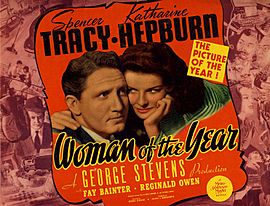
Tracy was supposed to star in The Yearling in 1942, but problems with filming stopped the production. This made him available for the new Katharine Hepburn film, Woman of the Year (1942). Hepburn greatly admired Tracy, calling him "the best movie actor there was." She was very happy he could work with her. The romantic comedy did well at the box office and received strong reviews. A critic wrote, "To begin with, it has Katharine Hepburn and Spencer Tracy in the leading roles. This in itself would be enough to make any film memorable."
Woman of the Year was followed by Tortilla Flat (1942), which got a weak response. MGM quickly paired Tracy and Hepburn again in the mystery Keeper of the Flame (1942). Even with weak reviews, this film earned more money than Woman of the Year, showing how strong their partnership was.
Tracy's next three films were about war. A Guy Named Joe (1943) with Irene Dunne became his highest-grossing film at the time. The Seventh Cross (1944), a suspense film about escaping a Nazi concentration camp, was highly praised. It was followed by the aviation film Thirty Seconds Over Tokyo (1944). Because of these three films, a poll showed Tracy was MGM's biggest money-making star of 1944. His only film the next year was his third with Hepburn, Without Love (1945), a romantic comedy that did well at the box office.
Stage Return and More Films
In 1945, Tracy returned to the stage for the first time in 15 years. He had been going through a difficult time, and Hepburn felt a play would help him focus. The play was The Rugged Path. It opened in Providence, Rhode Island, to a sold-out crowd but a weak response. Tracy found the production difficult and closed the show after just six weeks on Broadway in January 1946.
Tracy did not have any films released in 1946. His next film was The Sea of Grass (1947), a drama set in the American Old West with Hepburn. Like earlier films, critics gave it a lukewarm response, but it was a financial success. He then appeared in Cass Timberlane (1947), playing a judge. It was a commercial success.
A fifth film with Hepburn, Frank Capra's political drama State of the Union, was released in 1948. Tracy played a presidential candidate, and the movie was well-received. He then appeared in Edward, My Son (1949) with Deborah Kerr. Tracy disliked the role. The film became Tracy's biggest financial loss at MGM.
Tracy finished the 1940s with Malaya (1949), an adventure film with James Stewart. He also made Adam's Rib (1949), a comedy where Tracy and Hepburn played married lawyers who argue against each other in court. This film was written specifically for them by their friends, Garson Kanin and Ruth Gordon. Adam's Rib received strong reviews and became the highest-grossing Tracy-Hepburn movie so far. A film critic wrote, "Mr. Tracy and Miss Hepburn are the stellar performers in this show and their perfect compatibility in comic capers is delightful to see."
Last Years at MGM
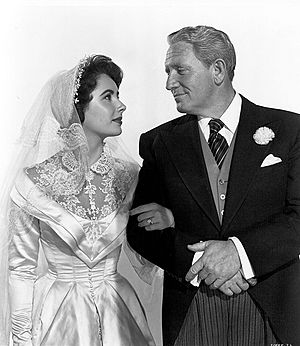
Tracy received his first Academy Award nomination in 12 years for playing Stanley Banks in Father of the Bride (1950). In this comedy, Banks tries to manage the wedding plans for his daughter, played by Elizabeth Taylor. Variety magazine said, "It's the second strong comedy in a row for Spencer Tracy, doing the title role, and he socks it." The film was Tracy's biggest commercial success at the time, earning $6 million worldwide. MGM wanted a sequel, and Tracy agreed. Father's Little Dividend (1951) was released ten months later and also did well. These two movies helped Tracy become one of the nation's top stars again.
Tracy played a lawyer in The People Against O'Hara (1951). He then teamed up with Hepburn again for the sports comedy Pat and Mike (1952). This was the second film written just for them by Kanin and Gordon. Pat and Mike became one of their most popular and praised films. Tracy followed it with Plymouth Adventure (1952), a historical drama about the Mayflower, co-starring Gene Tierney. This film did not do well and lost $1.8 million for MGM. Tracy returned to playing a caring father in The Actress (1953). For his performance in The Actress, Tracy won a Golden Globe Award and was nominated for a British Academy Film Award.
MGM loaned Tracy to Fox for the well-received Western film Broken Lance, his only film released in 1954. In 1955, Tracy turned down a role in The Desperate Hours because he didn't want to be second to Humphrey Bogart. Instead, Tracy starred as a one-armed man facing a hostile desert town in Bad Day at Black Rock (1955), directed by John Sturges. For this role, Tracy received his fifth Oscar nomination and won the Best Actor prize at the Cannes Film Festival.
Tracy was not happy with Bad Day at Black Rock and even threatened to leave during filming. This behavior became common for Tracy, who was often tired and irritable. He started filming Tribute to a Bad Man in 1955 but quit, claiming the mountain location gave him altitude sickness. These problems strained Tracy's relationship with MGM. In June 1955, with his contract up for renewal, Tracy decided to work as a freelance actor for the first time in his movie career.
Working Independently (1956–67)
Tracy's first film after leaving MGM was The Mountain (1956) with Robert Wagner. Filming in the French Alps was difficult, and Tracy again threatened to leave the project. His performance earned him a BAFTA nomination. Tracy and Hepburn then worked together for the eighth time in the comedy Desk Set (1957). He again had to be persuaded to stay with the film, which received a weak response.
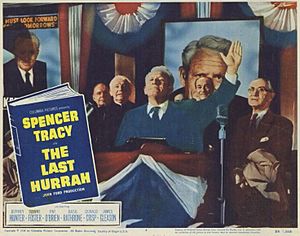
Tracy appeared in The Old Man and the Sea (1958), a project that had been planned for five years. It was based on Ernest Hemingway's famous story. Hemingway's agent believed Tracy was the perfect actor for the role. Tracy was thrilled to be offered the part. He was asked to lose weight before filming but didn't. Hemingway reportedly said Tracy was a "terrible liability" because of his weight, and the crew had to film him carefully. Tracy was alone on screen for most of the film and considered it his toughest role. A critic said his performance was "so intimate and revealing of universal human experience that... it almost transcended acting and became reality." Tracy received Oscar and BAFTA nominations for his work.
After turning down other projects, Tracy's next film was The Last Hurrah (1958). It reunited him with his first director, John Ford, after 28 years, and his childhood friend Pat O'Brien. Tracy took a year to agree to the project, where he played an Irish-American mayor. The movie received good reviews but was not a commercial success. At the end of 1958, the National Board of Review named Tracy the year's Best Actor. However, Tracy began to think about retiring, as he was often tired, unhappy, and ill.
Working with Stanley Kramer

Tracy did not appear on screen again until Inherit the Wind (1960). This film was based on the 1925 Scopes "Monkey Trial", which debated teaching evolution in schools. Director Stanley Kramer wanted Tracy for the role of lawyer Henry Drummond (based on Clarence Darrow). Tracy starred opposite Fredric March. Variety called their pairing "a stroke of casting genius." The film earned Tracy some of the best reviews of his career. He was nominated for an Academy Award, BAFTA Award, and Golden Globe Award, but the film was not a commercial hit.
In the volcano disaster movie The Devil at 4 O'Clock (1961), Tracy played a priest for the fourth time. His co-star, Frank Sinatra, allowed Tracy to have top billing to ensure he took the role. Tracy briefly pulled out of the production before returning. Critics were not excited about the film, but it was Tracy's most successful movie at the box office since Father of the Bride.
Inherit the Wind started a lasting partnership between Stanley Kramer and Tracy. Kramer directed Tracy's last three films. Judgment at Nuremberg, released in late 1961, was their second film together. The movie showed the trial of Nazi judges for their role in the Holocaust. Tracy called the script the best he had ever read. At the end of the film, Tracy delivered a 13-minute speech in one take, receiving applause from the cast and crew. The film received positive reviews and attracted a large audience. Tracy earned his eighth Oscar nomination for his performance.
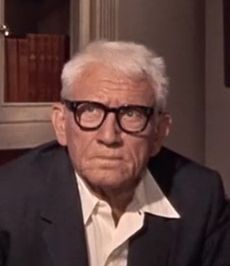
Tracy turned down roles in other films due to his declining health. Working became very challenging. In 1962, he took a small but important role in Kramer's comedy It's a Mad, Mad, Mad, Mad World (1963). He completed his scenes in nine days. The film was released in November 1963 and became one of the highest-grossing American films of the year. Tracy's name was at the top of the cast list. As his health worsened, he had to cancel other film commitments. Tracy did not work again until 1967. He took the starring role in Kramer's Guess Who's Coming to Dinner (1967), his ninth and final film with Hepburn.
Guess Who's Coming to Dinner explored the topic of interracial marriage. Tracy played a newspaper publisher whose beliefs are tested when his daughter wants to marry a black man, played by Sidney Poitier. Tracy was happy to be working again, but he told journalists it would be his last film due to his health. To start filming, Tracy needed a high insurance premium of $71,000 in case he died. Hepburn and Kramer put their salaries aside until Tracy finished his scenes. Because of his poor health, Tracy could only work for two or three hours each day. He finished his last scene on May 24, 1967. Spencer Tracy died 17 days later from a heart attack on June 10.
The film was released in December 1967. Although reviews were mixed, Tracy's performance was praised in almost every review. A critic wrote that Tracy gave "a faultless and, under the circumstances, heartbreaking performance." The movie became Tracy's highest-grossing film. He received a nomination for Best Actor—his ninth—at the 40th Academy Awards after his death. He also received a Golden Globe Award nomination and won a BAFTA for Best Actor.
Personal Life
Marriage and Family
Tracy met actress Louise Treadwell when they were both acting in a theater group. They got engaged in May 1923 and married on September 10 of that year.
Their son, John Ten Broeck Tracy, was born in June 1924. When John was 10 months old, Louise found out he was deaf. Tracy was very sad about this news and felt guilty about his son's deafness throughout his life. He believed it was a punishment for his own mistakes. Because of this, Tracy found it hard to connect with his son and became distant from his family. A second child, Louise "Susie" Treadwell Tracy, was born in July 1932.
Tracy left the family home in 1933. He and Louise openly told the media they were separated but remained friends and would not divorce.
Katharine Hepburn
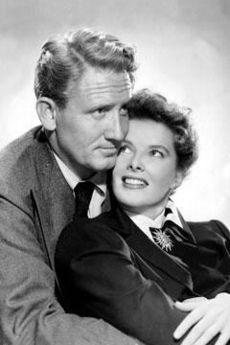
While making Woman of the Year in September 1941, Tracy began a long-lasting relationship with Katharine Hepburn. She became very devoted to him, and their relationship lasted until his death 26 years later. Tracy never moved back into his family home, but he visited regularly.
Tracy wanted to keep his relationship with Hepburn private from his wife, so it was hidden from the public. They did not live together until the last years of Tracy's life. At that time, they shared a cottage on director George Cukor's property in Beverly Hills. In Hollywood, however, their close partnership was widely known.
Neither Tracy nor his wife ever divorced, despite their separation.
Health and Passing
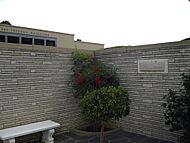
On July 21, 1963, Tracy was hospitalized because he had severe trouble breathing. Doctors found he had fluid in his lungs due to his heart not pumping well. His blood pressure was also dangerously high. From this point on, Tracy remained very weak. Katharine Hepburn moved into his home to care for him constantly. In January 1965, he was diagnosed with heart disease and also began treatment for previously ignored diabetes. Tracy almost died in September 1965. After a hospital stay, his kidneys failed, and he was in a coma for a night. His recovery the next day was called "a kind of miracle" by his doctor.
Tracy spent most of the next two years at home with Hepburn. She described their life as quiet, with him reading, painting, and listening to music. On June 10, 1967, 17 days after finishing his last film, Guess Who's Coming to Dinner, Tracy woke up at 3:00 am to make tea. Hepburn described finding him on the floor after hearing a cup smash. He had died from a heart attack. He was 67 years old. Hepburn said, "He looked so happy to be done with living, which for all his accomplishments had been a frightful burden for him."
A funeral service was held for Tracy on June 12. Close friends like George Cukor, Stanley Kramer, Frank Sinatra, James Stewart, and John Ford were pallbearers. Out of respect for Tracy's family, Katharine Hepburn did not attend the funeral. Tracy is buried at Glendale's Forest Lawn Memorial Park, near his wife Louise, son John, and daughter Susie.
Legacy and Recognition
Today, Spencer Tracy is often remembered for his partnership with Katharine Hepburn. Film experts still praise him. Critic Leonard Maltin calls Tracy "one of the 20th century's finest actors." Charles Matthews of The Washington Post says Tracy "deserves to be remembered for himself, as a master of acting technique."
The University of California, Los Angeles gives an award for excellent film acting in Tracy's name. Past winners of the UCLA Spencer Tracy Award include James Stewart, Michael Douglas, Denzel Washington, Tom Hanks, Anthony Hopkins, Kirk Douglas, and Morgan Freeman.
A 1986 PBS documentary called The Spencer Tracy Legacy was hosted by Hepburn. It included clips from his films, old footage, and interviews with his co-stars and daughter. In 2009, Tracy helped inspire the character Carl in Pixar's Oscar-winning film Up. Director Pete Docter said there is "something sweet about these grumpy old guys."
Several of Tracy's films are considered classics of American cinema, especially his comedies. He starred in four films on the American Film Institute's list of "100 Years ... 100 Laughs": Adam's Rib, It's a Mad, Mad, Mad, Mad World, Father of the Bride, and Woman of the Year. Guess Who's Coming to Dinner was on AFI's list of the 100 greatest American movies. Captains Courageous was on their list of America's most inspiring movies.
Awards and Nominations
Spencer Tracy was nominated for nine Academy Awards for Best Actor. This is a record he shares with Laurence Olivier. He was the first of nine actors to win the award twice, and one of only two actors to win it in consecutive years (the other being Tom Hanks). Tracy was also nominated for five British Academy Film Awards, winning two. He was nominated for four Golden Globe Awards, winning once. He also received the Cannes Film Festival award for Best Actor. The National Board of Review once named him Best Actor.
The Academy of Motion Picture Arts and Sciences recognized Tracy for these performances:
- 1937: Nomination for San Francisco
- 1938: Win for Captains Courageous
- 1939: Win for Boys Town
- 1951: Nomination for Father of the Bride
- 1956: Nomination for Bad Day at Black Rock
- 1959: Nomination for The Old Man and the Sea
- 1961: Nomination for Inherit the Wind
- 1962: Nomination for Judgment at Nuremberg
- 1968: Nomination for Guess Who's Coming to Dinner (after his death)
Filmography
Selected filmography:
- Up the River (1930) with Humphrey Bogart
- 20,000 Years in Sing Sing (1932) with Bette Davis
- The Power and the Glory (1933) with Colleen Moore
- Man's Castle (1933) with Loretta Young
- Whipsaw (1935) with Myrna Loy
- Fury (1936) with Sylvia Sidney
- San Francisco (1936) with Clark Gable
- Libeled Lady (1936) with Jean Harlow
- Captains Courageous (1937) with Freddie Bartholomew and Lionel Barrymore
- They Gave Him a Gun (1937)
- Mannequin (1937) with Joan Crawford and Alan Curtis
- Test Pilot (1938) with Clark Gable
- Boys Town (1938) with Mickey Rooney
- Boom Town (1940) with Clark Gable
- Edison, the Man (1940) with Gene Lockhart
- Northwest Passage (1940) with Robert Young and Walter Brennan
- Dr. Jekyll and Mr. Hyde (1941) with Ingrid Bergman
- Woman of the Year (1942) with Katharine Hepburn
- Ring of Steel (1942) as narrator
- Keeper of the Flame (1942) with Katharine Hepburn
- A Guy Named Joe (1943) with Irene Dunne
- The Seventh Cross (1944) with Hume Cronyn
- Thirty Seconds Over Tokyo (1944) with Van Johnson
- Without Love (1945) with Katharine Hepburn
- Sea of Grass (1947) with Katharine Hepburn
- State of the Union (1948) with Katharine Hepburn
- Adam's Rib (1949) with Katharine Hepburn
- Malaya (1949) with James Stewart
- Father of the Bride (1950) with Elizabeth Taylor
- Father's Little Dividend (1951) with Joan Bennett
- Plymouth Adventure (1952) with Gene Tierney
- Pat and Mike (1952) with Katharine Hepburn
- The Actress (1953) with Jean Simmons
- Broken Lance (1954) with Richard Widmark
- Bad Day at Black Rock (1955) with Robert Ryan
- The Mountain (1956) with Robert Wagner
- Desk Set (1957) with Katharine Hepburn
- The Old Man and the Sea (1958)
- The Last Hurrah (1958) with Jeffrey Hunter
- Inherit the Wind (1960) with Fredric March
- The Devil at 4 O'Clock (1961) with Frank Sinatra, Kerwin Mathews
- Judgment at Nuremberg (1961) with Burt Lancaster
- It's a Mad, Mad, Mad, Mad World (1963) with Jonathan Winters
- Guess Who's Coming to Dinner (1967) with Katharine Hepburn
Images for kids
See also
 In Spanish: Spencer Tracy para niños
In Spanish: Spencer Tracy para niños


